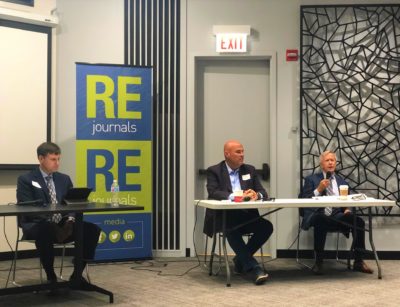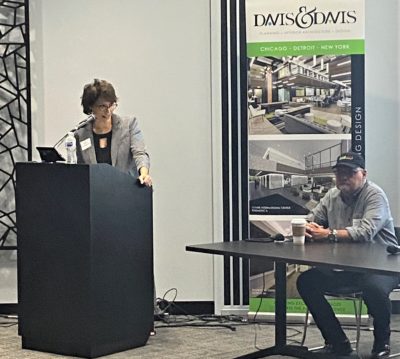You manage a downtown office, but the desks have been gathering dust throughout the pandemic. Your lease is nearing the end of its term and it’s time to decide: should we move to the suburbs?
Those are the facts for many businesses currently, as they share their employees’ concerns about packing into busy transit and walking through a dense downtown. Will COVID-19 have short- or long-term impacts on the downtown office market? And if so, how much might the suburban submarkets benefit?
That was the theme during last week’s 5th Annual State of Suburban Office Market Conference. A sold-out audience occupied the event in person at the O’Hare International Center Auditorium in Rosemont, Illinois, with more CRE professionals tuning in virtually.
 The first panel was moderated by John Joyce, CCIM, managing director, SVN Chicago Commercial. Joining him from a safe and socially distant six feet were Greg Bedalov, president and CEO, Choose DuPage Economic Development Alliance; Ron Lunt, partner, Hamilton Partners and Nick Weis, broker, Suburban Real Estate Services.
The first panel was moderated by John Joyce, CCIM, managing director, SVN Chicago Commercial. Joining him from a safe and socially distant six feet were Greg Bedalov, president and CEO, Choose DuPage Economic Development Alliance; Ron Lunt, partner, Hamilton Partners and Nick Weis, broker, Suburban Real Estate Services.
According to Weis, the process of ditching the CBD and fleeing to the car-friendly environs of the suburbs isn’t that easy. Most office tenants are committed to long-term leases that, unless they want to buy out, will keep them in the city. On top of that, Chicago office landlords are offering incentives to keep their tenants in place.
If moving is a timely and viable option, then the suburbs have a lot to offer: great schools, less congestion and quality office buildings. Realistically, there are great reasons to venture out—or return—to the suburbs. Weis expected to see increased demand for single-story properties as they provide more safety, more control and easier access.
Lunt reported that some banks have pulled back on the reins, even recasting existing loans in the face of COVID-19. Even if a new venture were to tick every box that the banks could ask for, many have until recently been too tied up with PPP loans to devote the manpower needed to sign off on new construction or acquisition loans.
The panel agreed that the work-from-home experiment will, in one form or another, continue to play out even after COVID-19 is under control. This, in turn, will have ramifications for the office sector at large.
“We always talk about Millennials, but Gen Y and Gen Z have grown up with screens,” said Bedalov. “The pandemic has worked very well with their worldview; they can do their work how they want and when they want, so they like working from home. I think that a large portion of the future workforce is perfectly okay with what is happening right now, and businesses are going to have to adapt.”

Karyn Charvat, executive director, PowerForward DuPage moderated the second panel. Joining her were Andy Bartucci, senior vice president, Foresite Realty; John Norris, senior managing director, Newmark Knight Frank; Terry Ramsett, founder and CEO, foodbarz! and Rod Zamparo, director of account sales, ARCO/Murray.
Some new deals have closed in the suburbs during the pandemic, but mostly with smaller tenants (five to 10 employees in size) who are more able to pivot. Norris echoed the sentiment of the first panel, saying that migration to suburbs will happen, it’s just not happening yet.
“There have been a lot of preliminary phone calls,” Norris said, “But people don’t want to pay on a second lease. We’re still very optimistic about the future. The question is when.”
The pandemic’s economic effects have been felt at every level, from banks to owners to office tenants to ancillary retail tenants. Ramsett—who operates food and convenience amenities in office buildings throughout Chicagoland—relayed his unfortunate experience during the past six months. He had to close 13 locations and renegotiated 17 deals, saying he’ll no longer pay base rent. Looking ahead, he’s developed four new menus that correlate with reopening phases, moving from grab-and-go to fresh food offerings as foot traffic gradually increases.
There have been other effects of the pandemic too. Bartucci discussed how important signage and communication have become, reminding tenants and facilities staff about mask usage and cleaning regimens. One trend that has been accelerated by COVID-19 is tenants reducing their on-site data center usage, moving more information to cloud-based options. This means that buildings are starting to see lower electrical loads, though they need increases in data capacity.
On the construction and development side, Zamparo said that past downturns have resulted in construction backlogs of 8 to 10 months and he expects a similar occurrence this time around. One silver lining is that construction pricing has corrected from the break-neck pace of year-over-year increases going into 2020.
Were you unable to join us for this conference? We have dozens more planned for the year—all with virtual options for those who would rather tune in remotely. Click here to see our schedule of upcoming events.
Source: REjournals
